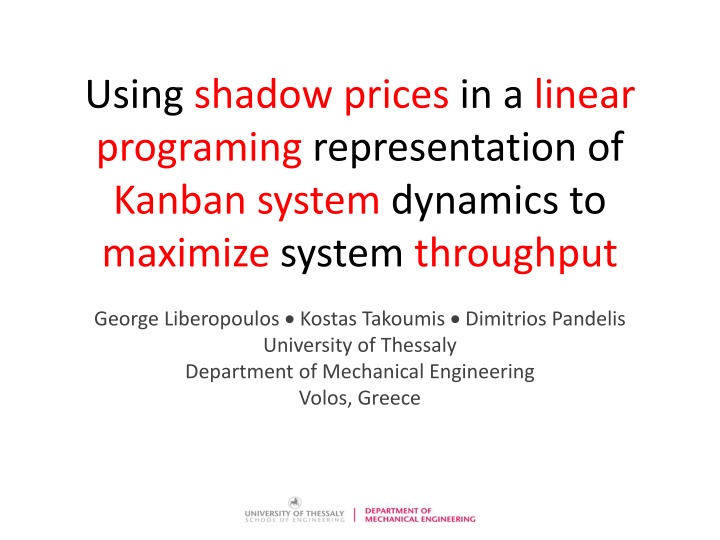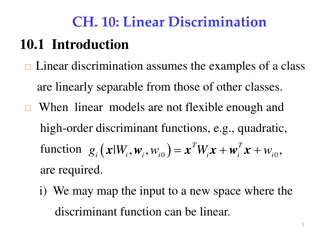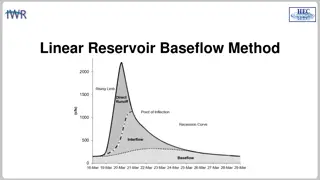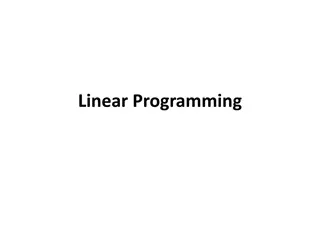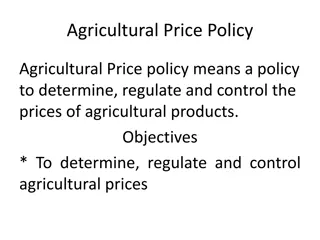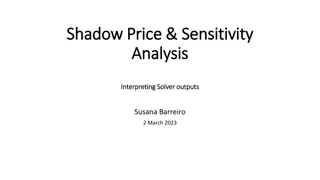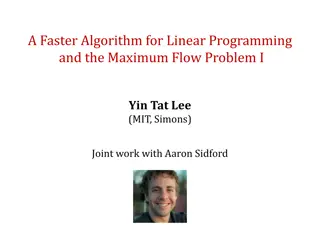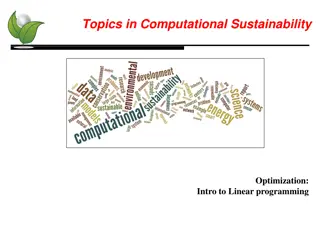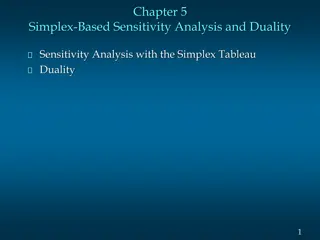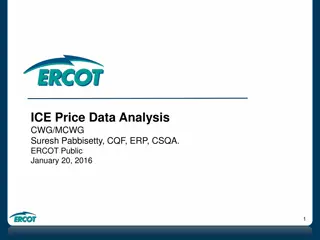Using Shadow Prices in Linear Programming for Kanban System
Mathematical programming models of discrete event dynamic systems can be represented using shadow prices in a linear programming approach. This method allows for maximizing system throughput and optimizing parameters efficiently. By converting event relationship graphs to mathematical programming problems, the system dynamics can be simulated and optimized using gradient-based numerical optimization techniques. This approach is particularly useful for parameter optimization and sensitivity analysis of discrete event systems, such as Kanban systems in manufacturing.
Download Presentation

Please find below an Image/Link to download the presentation.
The content on the website is provided AS IS for your information and personal use only. It may not be sold, licensed, or shared on other websites without obtaining consent from the author.If you encounter any issues during the download, it is possible that the publisher has removed the file from their server.
You are allowed to download the files provided on this website for personal or commercial use, subject to the condition that they are used lawfully. All files are the property of their respective owners.
The content on the website is provided AS IS for your information and personal use only. It may not be sold, licensed, or shared on other websites without obtaining consent from the author.
E N D
Presentation Transcript
Using shadow prices in a linear programing representation of Kanban system dynamics to maximize system throughput George Liberopoulos Kostas Takoumis Dimitrios Pandelis University of Thessaly Department of Mechanical Engineering Volos, Greece
Outline Introduction Linear Programming representation of kanban system dynamics Numerical results Conclusions 2
Introduction Mathematical Programing (MP) models of Discrete Event Dynamic Systems (DEDS) Shruben, L. W. 2000. Mathematical programming models of discrete event system dynamics. Proc. 2000 Winter Simulation Conf. IEEE, Piscataway, NJ, 381-385. Chan, W. K. V., L. Schruben. 2008. Optimization models of discrete-event system dynamics. Oper. Res. 56 (5) 1218-1237. Idea Represent a DEDS by an Event Relationship Graph (ERG) Convert ERG to an MP Problem Solving the MP Problem Simulating the DEDS 3
Introduction Manufacturing system applications Alfieri, A., A. Matta. 2012. Mathematical programming representation of pull controlled single-product serial manufacturing systems. J. Intell Manuf. 23 (1) 23-35. Advantages of method 1. Easy and elegant way to model system dynamics 2. Allows the use of efficient well-developed MP algorithms (e.g., Simplex) for DEDS simulation 3. Paves the way for exploiting MP theory (e.g., duality) for the detection of structural properties of the system Chan, W. K. V., L. W. Schruben. 2003. Properties of discrete-event systems from their mathematical programming representations. Proc. 2003 Winter Simulation Conf. IEEE, Piscataway, NJ, 496-502. 4. Paves the way for using MP techniques (e.g., sensitivity analysis) for parameter design and optimization 4
Introduction Parameter Optimization using MP representations of DEDS 1. Gradient-based numerical optimization 1. Solve LP problem ( simulate system) 2. Use shadow prices of the LP solution to compute (sample path) derivative estimates of performance w.r.t. parameters (equivalent to IPA derivative estimation) 3. Use derivatives estimates to drive a gradient-based stochastic optimization algorithm Suitable for continuous parameters that appear as constants in the LP problem (e.g., service times in a G/G/m queue) Chan, W. K. V., L. W. Schruben. 2006. Response gradient estimation using mathematical programming models of discrete-event system sample paths. Proc. 2006 Winter Simulation Conf. IEEE, Piscataway, NJ, 272-278. (G/G/1) Chan, W. K. V., N. Closser. 2013. Sensitivity analysis of linear programming formulations for G/G/M queue. Proc. 2013 Winter Simulation Conf. IEEE, Piscataway, NJ, 667-677. (G/G/M) 5
Introduction Optimization using MP representations of DEDS (cont d) 2. Simulate system and optimize parameters simultaneously Suitable for discrete parameters (e.g., buffers sizes in a production line, Kanban levels in a Kanban system) 1. Introduce 0/1 variables to represent all possible values of a discrete decision variable (e.g., buffer size, no. of kanbans, etc.) 2. LP problem MILP problem 3. Use LP approximation to the MILP problem Matta, A. 2008. Simulation optimization with mathematical programming representation of discrete event systems, Proc. 2008 Winter Simulation Conf. IEEE, Piscataway, NJ, 1393-1400. Alfieri, A., Matta, A., G. Pedrielli, 2011. Mathematical programming formulations for approximate simulation and optimization of closed-loop systems, Proc. SMMSO 2011, Kusadasi, Turkey, 85-92. Alfieri, A., A. Matta. 2012. Mathematical programming formulations for approximate simulation of multistage production systems. EJOR 219 773-783. Alfieri, A., Matta, A., G. Pedrielli, 2013. Integrating simulation modeling and optimization: An event based approach, Proc. SMMSO 2013, Seeon, Germany, 1-8. Matta, A., G. Pedrielli, A. Alfieri. 2014. ERG Lite: Event based modeling for simulation- optimization of control policies in discrete event systems, Proc. 2014 Winter Simulation Conf. IEEE, Piscataway, NJ, 3983-3994. 6
Introduction Our na ve approach: Use the gradient-based method (solve LP to simulate + use shadow prices to compute gradient estimates), but for discrete parameters (which appear as indexes of continuous decision variables in the LP formulation) See what happens! 7
LP representation of Kanban system kanbans Stage 4 raw parts DA1 DA2 DA3 DA4 finished parts WS1 WS2 WS3 WS4 PA2 P0 PA1 PA3 PA4 customer demands Stage 1 D5 Stage 3 Stage 2 8
LP representation of Kanban system kanbans raw parts DA1 DA2 DA3 DA4 finished parts WS1 WS2 WS3 WS4 PA2 P0 PA1 PA3 PA4 customer demands D5 ???: Workstation of stage ? modelled as a single-server queue containing stage-? in-process parts (WIP) with stage-? kanbans attached to them, ? = 1, ,? ???: Queue containing stage-? finished parts with stage-? kanbans attached to them, ? = 1, ,? ???: Queue containing free stage-? kanbans representing demands for stage-? parts from the next stage, ? = 1, ,? ??: Queue containing raw parts ??+?: Queue containing backordered customer demands 9
LP representation of Kanban system kanbans raw parts DA1 DA2 DA3 DA4 finished parts WS1 WS2 WS3 WS4 PA2 P0 PA1 PA3 PA4 customer demands D5 ??: Total number of stage-? kanbans, ? = 1, ,? ??: Arrival time of ?thraw part to the system, ? = 1, ,? ??: Arrival time of ?thcustomer demand to the system, ? = 1, ,? ??,?: Processing time of ?thpart in station ?,? = 1, ,?, ? = 1, ,? ??,?: Completion time of nthpart in station ?,? = 1, ,?, ? = 1, ,? ??,?: Departure time of ?thpart from stage ?,? = 1, ,?, ? = 1, ,? 10
LP representation of Kanban system kanbans raw parts DA1 DA2 DA3 DA4 finished parts WS1 WS2 WS3 WS4 PA2 P0 PA1 PA3 PA4 customer demands D5 Dynamics: max + evolution equations: ??,?= ??,?+ max ??,? 1,?? 1,?, ?0,?= ??, ??,? ??= 0, ??,?= max ??,? ??,??+1,?, ??+1,?= ??, ? = 1, ,?, ? = 1, ,? ? = 1, ,? ? = 0, ,?, ? = 0, ,?? ? = 0, ,?, ? = 1, ,? ? = 1, ,? Example: ?3,?= ?3,?+ max ?3,? 1,?2,? ?2,?= max ?2,? ?2,?3,? 11
LP representation of Kanban system LP representation of Kanban system dynamics ? ? ? min ?=1 ?=1 ??,?+ ?=0 ??,? s.t. ??,? ??,?+ ??,? 1 ??,? ??,?+ ?? 1,? ?0,?= ?? ??,? ??= 0 ? = 1, ,?, ? = 1, ,? ? = 1, ,?, ? = 1, ,? ? = 1, ,? ? = 0, ,?, ? = 0, ,?? ??,?= ??,?+ max ??,? 1,?? 1,? ??,? ??,? ?? ??,? ??+1,? ??+1,?= ?? ??,?,??,? 0 ? = 0, ,?, ? = 1, ,? ? = 0, ,?, ? = 1, ,? ? = 1, ,? ? = 0, ,?, ? = 1, ,? ??,?= max ??,? ??,??+1,? Solving the above LP is equivalent to simulating the Kanban system Input parameters: ??,??,??,?(random variates) Decision variables: ??,?, ??,? 12
LP representation of Kanban system This study Saturated Kanban system: Kanban system with infinite raw parts and customer demands ??= ??= 0, ? = 1, ,? kanbans kanbans raw parts DA1 DA1 DA2 DA2 DA3 DA3 DA4 DA4 finished parts parts finished WS1 WS1 WS2 WS2 WS3 WS3 WS4 WS4 PA2 PA2 P0 PA1 PA1 PA3 PA3 PA4 PA4 customer demands D5 The throughput of the saturated Kanban system defines the upper limit of the average customer demand rate that the regular kanban system can satisfy. 13
LP representation of Kanban system LP representation of Saturated Kanban system dynamics ? ? ? min ?=1 s.t. ?=1 ??,? ??,?+ ??,? 1 ??,? ??,?+ ?? 1,? ??,? ??= 0 ??,? ??,? ?? ??,? ??+1,? ??,?,??,? 0 ??,?+ ?=0 ??,? (shadow price) ? = 1, ,?, ? = 1, ,? ? = 1, ,?, ? = 1, ,? ? = 1, ,?, ? = 0, ,?? ? = 1, ,?, ? = 1, ,? ? = 0, ,? 1, ? = 1, ,? ? = 1, ,?, ? = 1, ,? ??,? (A) ?? ??,? ?? obj. fun throughput ??,? marginal in the objective function, if the rhs of (A) is slightly . Rhs of (A) , if ?? ??,?indirectly signals the in the objective function caused by a in ??, assuming that this affects only ??,? ??(for the specific value of ?). ?? ?=1 over all ?. ? ??,?indirectly signals the in the objective function caused by a in ??, 14
LP representation of Kanban system Optimization Problem Allocate a fixed number of kanbans, ?, among ? stages to maximize throughput. Iterative Solution Algorithm 1. Start with some initial allocation, e.g., uniform allocation of kanbans among stages. 2. In each iteration, solve LP and compute throughput and ??,? = 1,2, ,?. 3. Increase by one the number of kanbans of the stage with the highest ?? and decrease by one the number of kanbans of the stage with the lowest ??(stages with only one kanban are skipped). 4. Stop if the resulting allocation: 1. has been encountered in a previous iteration or 2. has one kanban in all stages but one 15
Numerical Results Table 2. Results for the 3-stage kanban system (N = 60,000). 0 0 0 0 % incr 1.33 1.34 0.44 0.34 0.02 0.02 2.15 1.80 0.47 0.07 1.52 1.22 0.39 0.07 1.53 1.21 0.29 0.05 ?1 ?2 ?3 ? 10 15 ?????? 0.8215 0.8705 0.8336 0.8764 0.9045 0.9380 0.9440 0.9703 0.9905 0.9971 0.9718 0.9899 1.0019 1.0065 0.9684 0.9869 0.9998 1.0033 ?1 ?2 ?3 ?????? 0.8324 0.8822 0.8373 0.8794 0.9047 0.9382 0.9643 0.9878 0.9952 0.9978 0.9866 1.0020 1.0058 1.0072 0.9832 0.9988 1.0027 1.0038 ?1 ?2 ?3 1 1 1 3 5 2 3 3 5 2 3 3 5 2 3 3 5 2 3 2 5 4 5 2 2 4 5 2 2 4 5 2 2 4 5 2 2 2 5 3 5 2 3 3 5 2 3 3 5 2 3 3 5 2 3 2 5 1 1 1 1 1 6 1 1 1 1 1 1 1 1 2 4 2 4 8 1 1 1 2 3 6 1 1 1 2 1 1 2 9 1 1 1 1 13 1 2 1 6 8 4 5 6 3 4 6 8 10 15 2 1 2 6 8 10 15 12 3 2 1 6 8 4 6 7 5 3 3 7 10 15 1 2 3 6 8 10 15 10 16
Numerical Results vs. ? for the 3-stage kanban system (? = 60,000). Figure 3. Plots of ??and ?? 6 14 12 5 10 4 8 K = 6 3 6 K = 8 K = 10 2 4 K = 10 K = 15 1 2 K = 15 0 0 1 2 3 1 2 3 stage stage 17
Numerical Results vs. ? for the 3-stage kanban system (? = 60,000). Figure 3. Plots of ??and ?? 10 10 8 8 6 6 K = 6 K = 6 4 4 K = 8 K = 8 K = 10 K = 10 2 2 K = 15 K = 15 0 0 1 2 3 1 2 3 stage stage 18
Numerical Results Table 3. Results for the 5-stage kanban system (N = 50,000). ?2 ?3 ?4 ?5 0?3 0 0?2 0?4 0?5 0 % incr ?1 ?2 ?3 ?4 ?5 ? ?????? ?1 ?????? ?1 1 1 1 1 1 6 7 8 1 1 1 2 3 1 1 1 2 3 2 2 2 2 3 2 2 2 2 3 1 2 2 2 3 1 2 2 2 3 1 1 2 2 3 1 1 2 2 3 1 1 1 2 3 1 1 1 2 3 0.5280 0.5767 0.6258 0.6653 0.7512 0.6005 0.6214 0.6740 0.7228 0.8009 1 1 1 1 1 1 1 1 1 1 1 2 2 3 5 2 2 3 4 6 2 1 2 2 3 1 1 1 1 1 1 2 2 3 5 1 2 2 3 6 1 1 1 1 1 1 1 1 1 1 0.5397 0.5844 0.6258 0.6815 0.7655 0.6005 0.6559 0.6864 0.7414 0.8196 2.22 1.34 0.00 2.43 1.90 0.00 5.55 1.84 2.57 2.33 10 15 1 1 4 1 1 6 7 8 10 15 19
Numerical Results vs. ? for the 5-stage kanban system (? = 50,000). Figure 4. Plots of ??and ?? 5 6 5 4 4 3 K = 6 K = 6 3 K = 7 K = 7 2 2 K = 8 K = 8 1 1 K = 10 K = 10 K = 15 K = 15 0 0 1 2 3 4 5 1 2 3 4 5 stage stage 20
Numerical Results Table 4. Results for the 6-stage kanban system (N = 30,000). ?6 ?2 ?3 ?4 ?5 0?3 0 0?2 0?4 0?5 0?6 0 % incr ?1 ?2 ?3 ?4 ?5 ?6 ? ?????? ?1 ?????? ?1 1 1 2 1 3 1 3 1 2 1 1 1 18 3 1 1 2 3 3 3 1 1 2 3 3 3 2 2 2 3 3 3 1 2 2 3 3 3 1 1 2 3 3 3 1 1 2 3 3 0.9446 0.5076 0.5459 0.6482 0.7374 0.8542 3 1 1 1 1 1 5 1 1 3 5 1 2 1 2 2 3 7 2 2 1 2 3 7 4 1 2 3 5 1 2 1 1 1 1 1 0.9469 0.5083 0.5469 0.6605 0.7497 0.9265 0.24 0.14 0.18 1.90 1.67 8.46 7 8 12 18 18 3 2 1 1 2 3 21
Numerical Results vs. ? for the 6-stage kanban system (? = 30,000). Figure 5. Plots of ??and ?? 5 5 4 4 3 3 K = 7 2 2 K = 8 K = 18 K = 12 1 1 K = 18 0 0 1 2 3 4 5 6 1 2 3 4 5 6 stage stage 7 6 5 4 3 2 K = 18 1 0 1 2 3 4 5 6 stage 22
Numerical Results Table 5. Results for the 10-stage kanban system (N = 10,000). ?6 1 ?2 ?3 1 ?4 1 ?5 2 ?7 1 ?8 2 ?9 1 ?10 1 ?????? 1 0.4765 1.56 0?2 0?3 1 0?5 1 0?8 1 0 0?4 1 0?6 2 0?7 2 0?9 1 0?10 1 0?????? 1 0.4692 1 % incr ?1 ?2 ?3 ?4 ?5 ?6 ?7 ?8 ?9?10? ?1 1 1 1 1 1 1 ?1 1 1 1 1 12 1 vs. ? for the 10-stage kanban system (? = 10,000). Figure 5. Plots of ??and ?? 2 1 K = 12 0 1 2 3 4 5 6 7 8 9 10 stage 23
Numerical Results ?,?? vs. stage ? and iteration ?, for the 6-stage kanban system with ?1, ,?6 = (3,2,1,1,2,3). ?, and ?????? ? Figure 7. Plots of ?? number of kanbans kij 2.00E+08 8 gradient ij 1.50E+08 0 6 0 iteration j iteration j 1.00E+08 4 2 2 5.00E+07 2 4 4 0.00E+00 0 1 2 3 4 5 6 1 2 3 stage i 4 5 6 stage i 0.9300 0.9200 0.9100 throughput 0.9000 0.8900 0.8800 0.8700 0.8600 0.8500 0 1 2 3 4 iteration 24
Conclusions We experimented with a quick and dirty method for optimizing the number of kanbans in a Kanban system to maximize throughput. The shadow prices of the LP representation of kanban system dynamics seem to point to the right direction for improving system throughput. For the 5-, 6-, and 10-stage kanban systems, the results indicate that the optimal kanban allocation has a or M shape, where the crease in the middle is more pronounced for larger values of ?. The optimization is crude and may not always lead to the optimal solution, especially if the objective function of the LP is insensitive to the parameters (kanban levels). However, it seems to be sufficient for finding good enough solutions for practical purposes or for use as initial solutions for more sophisticated algorithms. 25
Acknowledgement This work was supported by grant MIS 379526 Odysseus: A holistic approach for managing variability in contemporary global supply chain networks, which was co-financed by the European Union (European Social Fund - ESF) and Greek national funds through the Operational Program Education and Lifelong Learning of the National Strategic Reference Framework (NSRF) - Research Funding Program: THALES: Reinforcement of the interdisciplinary and/or inter-institutional research and innovation. 26
Thank you for your patience. Any questions? 27
